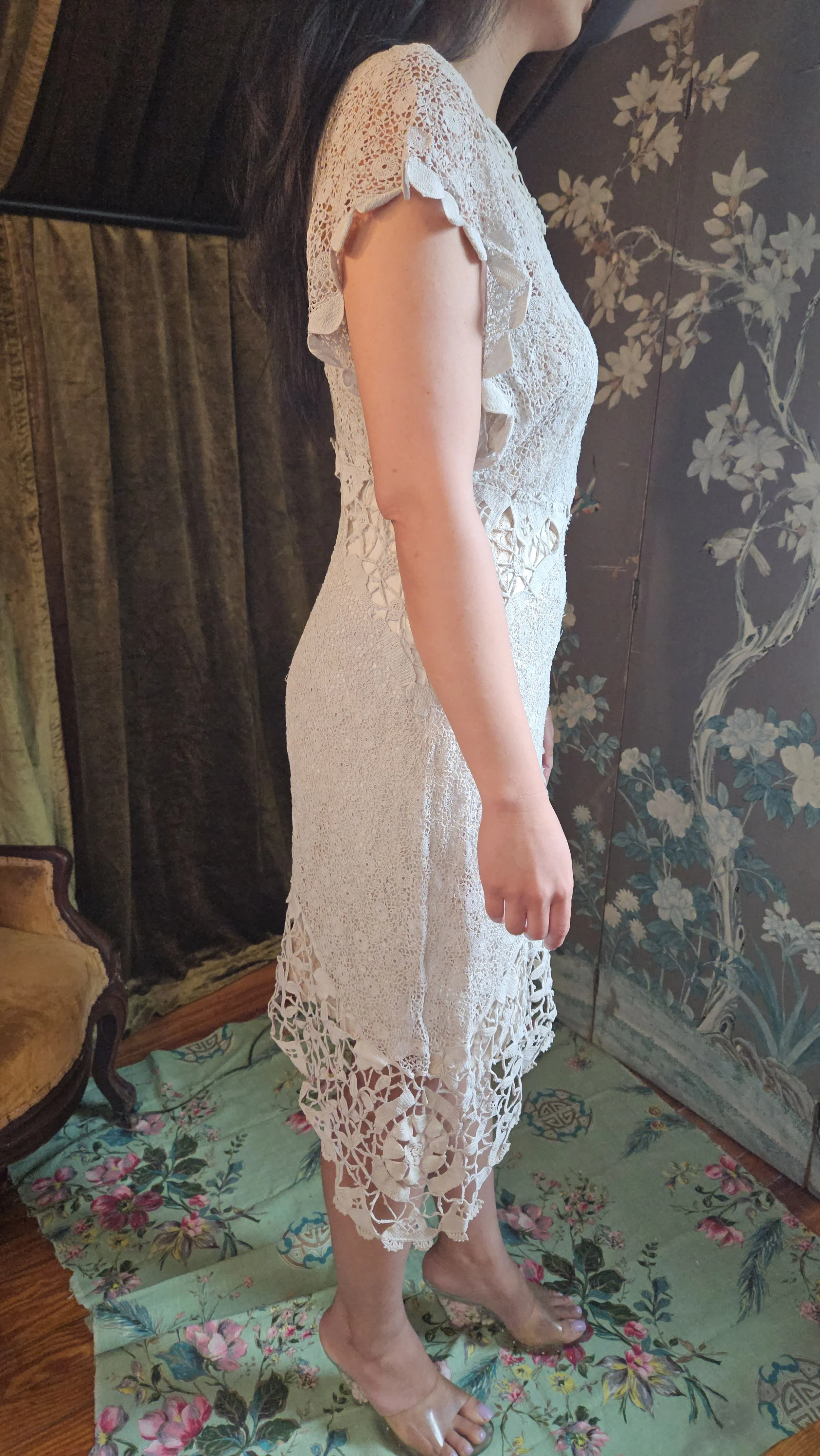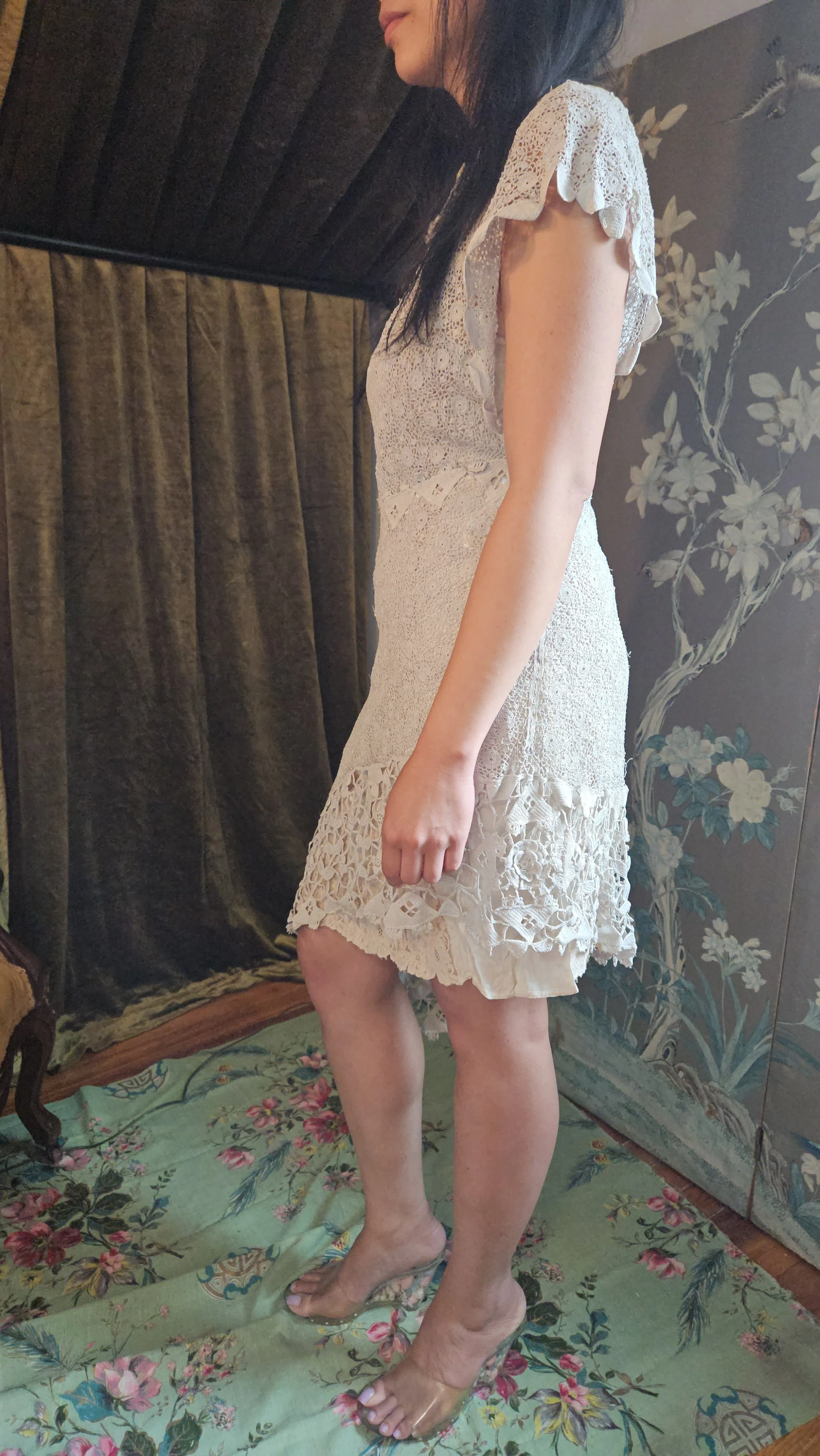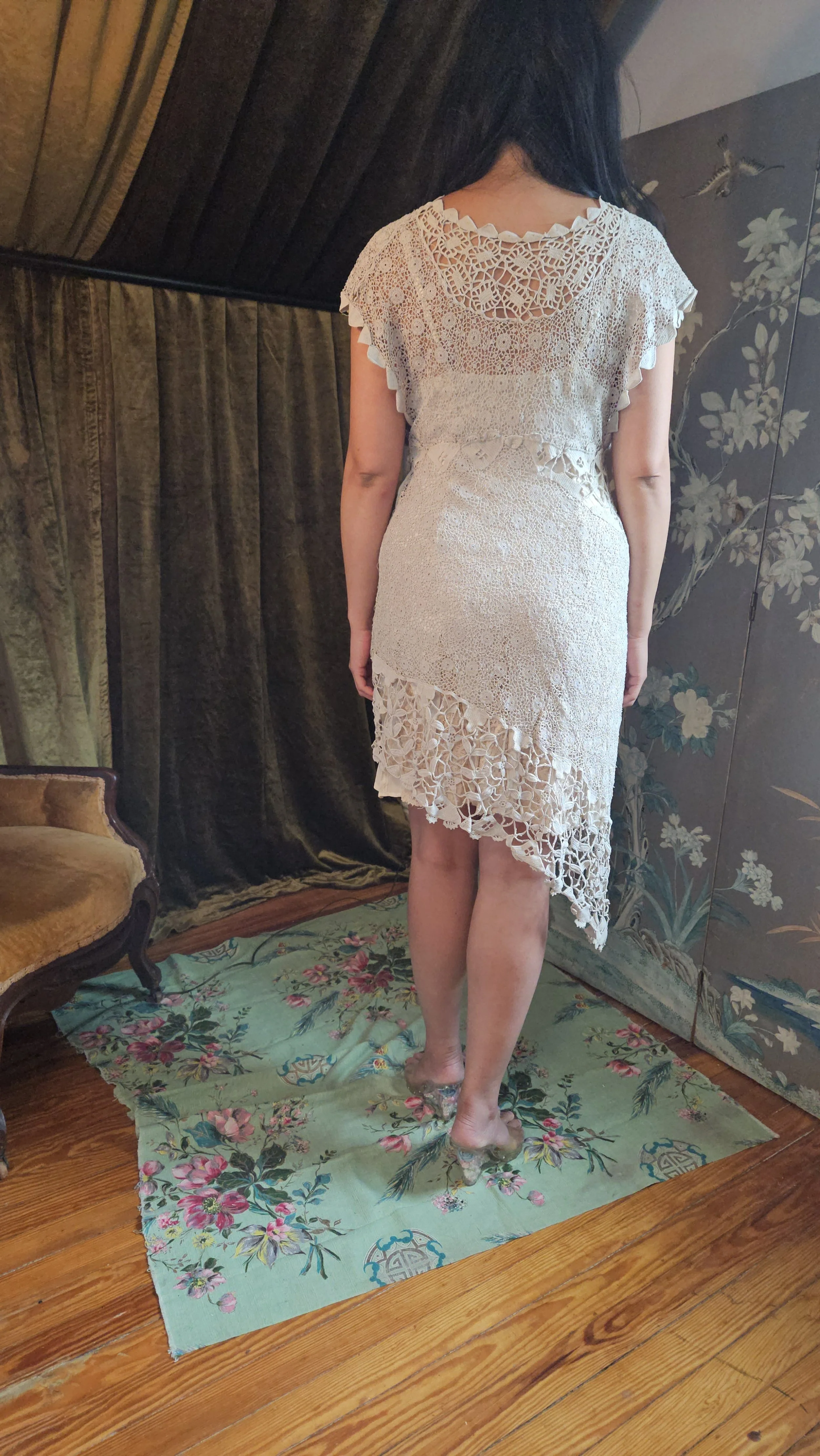 Image 1 of 6
Image 1 of 6

 Image 2 of 6
Image 2 of 6

 Image 3 of 6
Image 3 of 6

 Image 4 of 6
Image 4 of 6

 Image 5 of 6
Image 5 of 6

 Image 6 of 6
Image 6 of 6







Unique Antique Ice Grey Crochet Lace Overlay Tunic or Dress with Asymmetrical Hem (c. 1900s-10s)
This is a fascinating and interesting hand crocheted lace tunic style overlay in a lovely dove grey / blue/ lavender pastel tone.
A rare and breathtaking example of early 20th-century craftsmanship, this original Edwardian lace tunic dress is a living piece of history. Dating from the 1900s to 1910s, it embodies the romantic femininity and artisanal detail that defined the era. Made entirely from fine cotton lace with intricate handwork, this garment was likely worn as a tunic or over-dress — a luxurious layer meant to elevate a woman’s silhouette with elegance and lightness.
Its design features the hallmarks of Edwardian style: a high lace neckline, fluttering sleeves, and a delicately draped fit that floats gently over the body. The asymmetrical hem, with its bold floral openwork lace, adds a touch of whimsy that remains striking even over a century later. Whether displayed as a collectible or worn as a statement of antique fashion, this tunic dress offers timeless grace.
This was likely layered over a beautiful full length white cotton walking skirt. Today, it can be worn simply as a dress, over pants, or as historically intended over a long skirt.
This is more than a garment — it’s a wearable heirloom. Perfect for collectors, historical costumers, vintage bridal styling, or those who simply cherish the beauty of true antique fashion.
Features:
Authentic antique piece from the Edwardian era (c. 1900s–1910s)
Asymmetrical hem, bodice, and waist
Deco style geometric inserts
Armholes are open to the waist.
Single snap at left side
Garment Measurements:
Bust (measured flat, from pit to pit): somewhat open due to cut of armholes, measures 18 inches across
Waist: 31 inches
Hips: approx. 36-39 inches
Bodice length: 15 inches
Skirt length: 18-31 inches
Fit: S/M/L
Notes:
Some stretch/give to measurements due to crochet construction
Excellent condition, very sturdy and wearable with no major flaws to note
Left side seams have been stitched up in a slightly darker colored thread though not distracting, it could be easily removed and redone if desired
Freshly laundered
The history of Irish crochet lace: a legacy of resilience and beauty
Irish crochet lace, a distinctive and highly valued textile art form, emerged from a poignant chapter in Irish history and continues to hold significant cultural and artistic value today.
A lifeline during the Great Famine
The mid-19th century witnessed the devastation of the Great Irish Famine (1845-1849), when widespread potato crop failure led to starvation and mass emigration. In this desperate time, Irish crochet lace became a lifeline, providing a much-needed source of income for impoverished families.
Inspired by Venetian Lace: The techniques of Irish crochet were developed to mimic the intricate beauty of expensive Venetian point lace, making it a desirable alternative for the upper classes.
Teaching and Enterprise: Nuns in convents and relief schools, established in part due to famine relief efforts, taught the craft to women and girls across the country. These schools and stores not only provided education but also served as outlets for selling the handmade lace.
Cottage Industry: This fostered a thriving cottage industry where families and communities specialized in creating individual motifs – flowers, leaves, and other designs – which were then assembled into larger pieces like collars, cuffs, and dresses.
Why Irish crochet is valued today
Irish crochet's value today extends beyond its historical significance, encompassing its inherent artistry, cultural importance, and growing appeal in the modern craft and fashion worlds.
Intricate Beauty and Craftsmanship: Irish crochet is renowned for its delicate and intricate designs, including motifs like flowers, shamrocks, and grapevines. The use of padded cords and various stitches creates a unique three-dimensional texture, showcasing the skill and dedication of the lacemaker.
Connection to the Maker and Storytelling: Irish crochet is a tangible link to Ireland's past, particularly the resilience and resourcefulness of the Irish people during challenging times. Each piece of Irish crochet tells a story – a story of skill, dedication, and the history embedded in its creation. This personal connection to the maker and the narrative behind the craft contributes to its intrinsic value.
This is a fascinating and interesting hand crocheted lace tunic style overlay in a lovely dove grey / blue/ lavender pastel tone.
A rare and breathtaking example of early 20th-century craftsmanship, this original Edwardian lace tunic dress is a living piece of history. Dating from the 1900s to 1910s, it embodies the romantic femininity and artisanal detail that defined the era. Made entirely from fine cotton lace with intricate handwork, this garment was likely worn as a tunic or over-dress — a luxurious layer meant to elevate a woman’s silhouette with elegance and lightness.
Its design features the hallmarks of Edwardian style: a high lace neckline, fluttering sleeves, and a delicately draped fit that floats gently over the body. The asymmetrical hem, with its bold floral openwork lace, adds a touch of whimsy that remains striking even over a century later. Whether displayed as a collectible or worn as a statement of antique fashion, this tunic dress offers timeless grace.
This was likely layered over a beautiful full length white cotton walking skirt. Today, it can be worn simply as a dress, over pants, or as historically intended over a long skirt.
This is more than a garment — it’s a wearable heirloom. Perfect for collectors, historical costumers, vintage bridal styling, or those who simply cherish the beauty of true antique fashion.
Features:
Authentic antique piece from the Edwardian era (c. 1900s–1910s)
Asymmetrical hem, bodice, and waist
Deco style geometric inserts
Armholes are open to the waist.
Single snap at left side
Garment Measurements:
Bust (measured flat, from pit to pit): somewhat open due to cut of armholes, measures 18 inches across
Waist: 31 inches
Hips: approx. 36-39 inches
Bodice length: 15 inches
Skirt length: 18-31 inches
Fit: S/M/L
Notes:
Some stretch/give to measurements due to crochet construction
Excellent condition, very sturdy and wearable with no major flaws to note
Left side seams have been stitched up in a slightly darker colored thread though not distracting, it could be easily removed and redone if desired
Freshly laundered
The history of Irish crochet lace: a legacy of resilience and beauty
Irish crochet lace, a distinctive and highly valued textile art form, emerged from a poignant chapter in Irish history and continues to hold significant cultural and artistic value today.
A lifeline during the Great Famine
The mid-19th century witnessed the devastation of the Great Irish Famine (1845-1849), when widespread potato crop failure led to starvation and mass emigration. In this desperate time, Irish crochet lace became a lifeline, providing a much-needed source of income for impoverished families.
Inspired by Venetian Lace: The techniques of Irish crochet were developed to mimic the intricate beauty of expensive Venetian point lace, making it a desirable alternative for the upper classes.
Teaching and Enterprise: Nuns in convents and relief schools, established in part due to famine relief efforts, taught the craft to women and girls across the country. These schools and stores not only provided education but also served as outlets for selling the handmade lace.
Cottage Industry: This fostered a thriving cottage industry where families and communities specialized in creating individual motifs – flowers, leaves, and other designs – which were then assembled into larger pieces like collars, cuffs, and dresses.
Why Irish crochet is valued today
Irish crochet's value today extends beyond its historical significance, encompassing its inherent artistry, cultural importance, and growing appeal in the modern craft and fashion worlds.
Intricate Beauty and Craftsmanship: Irish crochet is renowned for its delicate and intricate designs, including motifs like flowers, shamrocks, and grapevines. The use of padded cords and various stitches creates a unique three-dimensional texture, showcasing the skill and dedication of the lacemaker.
Connection to the Maker and Storytelling: Irish crochet is a tangible link to Ireland's past, particularly the resilience and resourcefulness of the Irish people during challenging times. Each piece of Irish crochet tells a story – a story of skill, dedication, and the history embedded in its creation. This personal connection to the maker and the narrative behind the craft contributes to its intrinsic value.